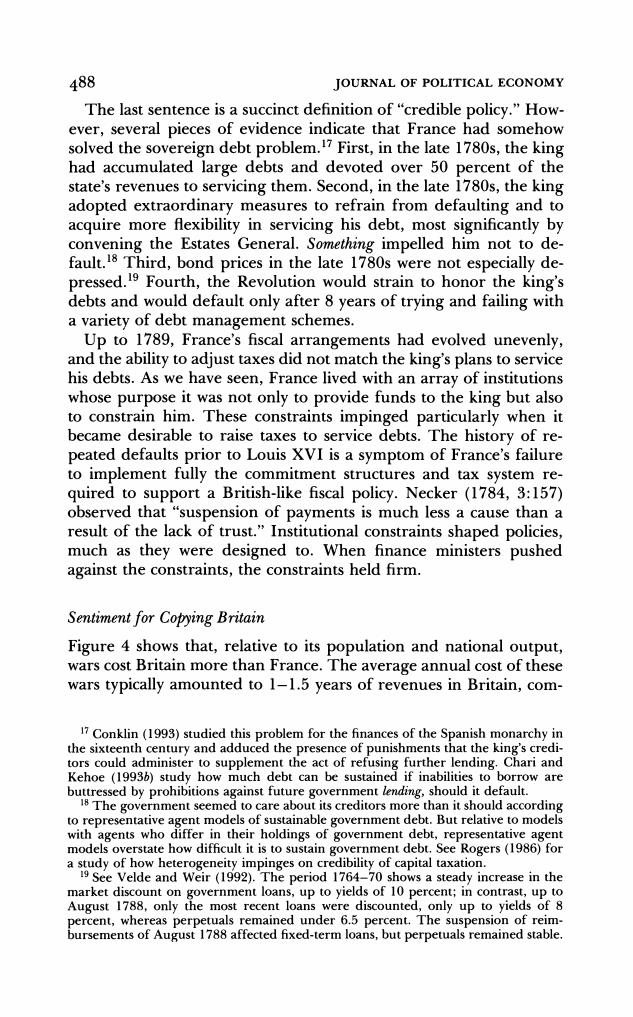正在加载图片...

488 JOURNAL OF POLITICAL ECONOMY The last sentence is a succinct definition of"credible policy."How- ever,several pieces of evidence indicate that France had somehow solved the sovereign debt problem.17 First,in the late 1780s,the king had accumulated large debts and devoted over 50 percent of the state's revenues to servicing them.Second,in the late 1780s,the king adopted extraordinary measures to refrain from defaulting and to acquire more flexibility in servicing his debt,most significantly by convening the Estates General.Something impelled him not to de- fault.18 Third,bond prices in the late 1780s were not especially de- pressed.19 Fourth,the Revolution would strain to honor the king's debts and would default only after 8 years of trying and failing with a variety of debt management schemes. Up to 1789,France's fiscal arrangements had evolved unevenly, and the ability to adjust taxes did not match the king's plans to service his debts.As we have seen,France lived with an array of institutions whose purpose it was not only to provide funds to the king but also to constrain him.These constraints impinged particularly when it became desirable to raise taxes to service debts.The history of re- peated defaults prior to Louis XVI is a symptom of France's failure to implement fully the commitment structures and tax system re- quired to support a British-like fiscal policy.Necker(1784,3:157) observed that "suspension of payments is much less a cause than a result of the lack of trust."Institutional constraints shaped policies, much as they were designed to.When finance ministers pushed against the constraints,the constraints held firm. Sentiment for Copying Britain Figure 4 shows that,relative to its population and national output, wars cost Britain more than France.The average annual cost of these wars typically amounted to 1-1.5 years of revenues in Britain,com- 17 Conklin(1993)studied this problem for the finances of the Spanish monarchy in the sixteenth century and adduced the presence of punishments that the king's credi- tors could administer to supplement the act of refusing further lending.Chari and Kehoe (1993b)study how much debt can be sustained if inabilities to borrow are buttressed by prohibitions against future government lending,should it default. iThe government seemed to care about its creditors more than it should according to representative agent models of sustainable government debt.But relative to models with agents who differ in their holdings of government debt,representative agent models overstate how difficult it is to sustain government debt.See Rogers(1986)for a study of how heterogeneity impinges on credibility of capital taxation. 19 See Velde and Weir (1992).The period 1764-70 shows a steady increase in the market discount on government loans,up to yields of 10 percent;in contrast,up to August 1788,only the most recent loans were discounted,only up to yields of 8 percent,whereas perpetuals remained under 6.5 percent.The suspension of reim- oursements of August 1788 affected fixed-term loans,but perpetuals remained stable.488 JOURNAL OF POLITICAL ECONOMY The last sentence is a succinct definition of "credible policy." However, several pieces of evidence indicate that France had somehow solved the sovereign debt problem.'7 First, in the late 1780s, the king had accumulated large debts and devoted over 50 percent of the state's revenues to servicing them. Second, in the late 1780s, the king adopted extraordinary measures to refrain from defaulting and to acquire more flexibility in servicing his debt, most significantly by convening the Estates General. Something impelled him not to default.'8 Third, bond prices in the late 1780s were not especially depressed.'9 Fourth, the Revolution would strain to honor the king's debts and would default only after 8 years of trying and failing with a variety of debt management schemes. Up to 1789, France's fiscal arrangements had evolved unevenly, and the ability to adjust taxes did not match the king's plans to service his debts. As we have seen, France lived with an array of institutions whose purpose it was not only to provide funds to the king but also to constrain him. These constraints impinged particularly when it became desirable to raise taxes to service debts. The history of repeated defaults prior to Louis XVI is a symptom of France's failure to implement fully the commitment structures and tax system required to support a British-like fiscal policy. Necker (1784, 3:157) observed that "suspension of payments is much less a cause than a result of the lack of trust." Institutional constraints shaped policies, much as they were designed to. When finance ministers pushed against the constraints, the constraints held firm. Sentiment for Copying Britain Figure 4 shows that, relative to its population and national output, wars cost Britain more than France. The average annual cost of these wars typically amounted to 1-1.5 years of revenues in Britain, com- 17 Conklin (1993) studied this problem for the finances of the Spanish monarchy in the sixteenth century and adduced the presence of punishments that the king's creditors could administer to supplement the act of refusing further lending. Chari and Kehoe (1993b) study how much debt can be sustained if inabilities to borrow are buttressed by prohibitions against future government lending, should it default. 18 The government seemed to care about its creditors more than it should according to representative agent models of sustainable government debt. But relative to models with agents who differ in their holdings of government debt, representative agent models overstate how difficult it is to sustain government debt. See Rogers (1986) for a study of how heterogeneity impinges on credibility of capital taxation. 19 See Velde and Weir (1992). The period 1764-70 shows a steady increase in the market discount on government loans, up to yields of 10 percent; in contrast, up to August 1788, only the most recent loans were discounted, only up to yields of 8 percent, whereas perpetuals remained under 6.5 percent. The suspension of reimbursements of August 1788 affected fixed-term loans, but perpetuals remained stable